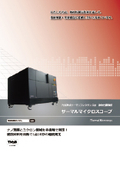Measurement of thermal conductivity of thermal pads
Request measurement using the steady-state thermal conductivity measurement method SS-H40.
Are you measuring the correct thermal conductivity of the thermal pad?
A thermal pad is a type of thermal interface material used for heat dissipation in CPUs and power devices. Due to its flexibility and relatively high thermal conductivity, it effectively reduces contact thermal resistance by filling the gaps between the heat sink and the device. Do you accurately understand the thermal conductivity of thermal pads? Thermal pads have elasticity, so their contact state changes with pressure. In other words, the effective thermal conductivity varies with pressure. Additionally, many materials exhibit temperature dependence in thermal conductivity, meaning that as the temperature increases, the thermal conductivity decreases. In this instance, we measured a commercially available thermal pad with a specification of 1.5W/mK. This is a soft type referred to as a soft thermal pad. The measurement device used is our steady-state thermal conductivity measurement device, the SS-H40.
Inquire About This Product
basic information
Specifications of the measured thermal pad Size: 40mm x 40mm x 5 mm Thermal conductivity: 1.5 W/m·K Heat resistance temperature: 50–200 (°C) First, we measured the sample by changing the pressure. Measurement conditions Sample temperature: 30°C Pressure: 200N, 400N, 600N, 800N Figure 2: Load and thermal conductivity As the load increased, the thermal conductivity rose and became almost constant at 600N. When the load is insufficient, the material and the thermal pad do not make sufficient contact, resulting in a large contact thermal resistance and lower thermal conductivity. However, when the load is sufficient, they make contact, reducing the contact thermal resistance and increasing the thermal conductivity. Next, we measured the sample by changing the temperature. Measurement conditions Sample temperature: 30°C, 40°C, 50°C Pressure: 600N Figure 3: Sample temperature and thermal conductivity As the sample temperature increased, the thermal conductivity decreased. The thermal conductivity decreased by 3.3% at sample temperatures of 30°C and 40°C, but only by 0.5% between 40°C and 50°C. Since all materials experience changes in thermal conductivity to varying degrees with temperature changes, it is important to understand this effect.
Price information
For a detailed price list of the requested measurements, please see the URL below. https://hrd-thermal.jp/measurement/value/
Price range
P3
Delivery Time
P4
※We will report within approximately two weeks from the time we receive the sample.
Applications/Examples of results
Acquisition of thermal design simulation data for power devices, CPUs, AI chips, lithium-ion batteries, etc. Measurement of thermal conductivity for various TIMs (thermal interface materials) such as thermal pads.
Detailed information
-

Figure 1 Thermal Pad
-

Figure 2: Load and thermal conductivity: The effective thermal conductivity changes as the softness of the sample affects the adhesion when the load is altered.
-

Figure 3: Sample Temperature and Thermal Conductivity: The thermal conductivity of various materials changes with temperature. Let's measure the thermal conductivity at the temperature used in practice.
catalog(3)
Download All CatalogsNews about this product(7)
Company information
Leveraging the assembly technology cultivated over many years, we have expanded our business areas to include the development of precision component assembly, thermal property measurement devices, contract measurement services, and the development of medical and dental plastic products equipped with clean rooms. We deepen and integrate our "original products" from a unique manufacturing perspective, consolidating our know-how and technology. With "speedy decision-making and execution," which is a strength unique to Bethel, we provide high-quality products under the "Made by BETHEL" label. Our wish at Bethel is for our customers who use Bethel products to be satisfied with our products, manufacturing, and services, and to feel that they made the right choice in trusting our company. Furthermore, we hope that the satisfaction of our customers will lead to the happiness of each employee who works here.


















